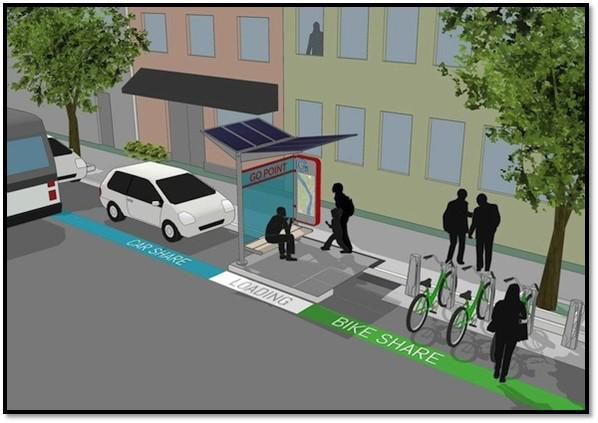Bike share programs work best when docking stations are located in areas of high demand for both origin & destination trips. Siting also includes considerations for the immediate environment to ensure ease of access, comfort & safety,
Benefits & Problems Addressed
Multi-Modal System Expansion: Bike share expands availability of bicycles and use of multi-modal infrastructure such as bicycle lanes. Bike share also expands the reach of transit by reducing the time needed to access bus & rail stations.
Careful siting increases ridership: Poorly located stations will not attract as many users as stations in areas with higher demand.
Increased safety for all modes: Careful planning ensure stations are located away from potential conflict points with other modes. Bike share docks and stations should also be in areas with good drainage, lighting & visibility.
Manage program costs: Bike share stations are highly visible and part of advertising (for advertisers & for the system itself).Planning also factors in rebalancing (programs reshuffle bike among stations to meet demand).
Tips & Techniques
Siting Goals: Set locally-relevant and important goals, that can include (1) Convenient access, (2) Financial feasibility, (3) User safety, (4) Equitable & geographically varied station placement, and (5) Integrated into a multi-modal system.
Important siting location factors: (1) At rail and high capacity bus stations. (2) Access to regional bike trails & high quality bike lanes. (3) Near economic hubs such as downtowns & universities. (4) Topography.
Users will need good Wi-Fi and phone service to access the bike share app.
Tourism: Bike share can be a critical element in tourism planning where tourists can make self-directed rides to see various sites. One-day passes typically cost more per rider and are an important part of revenue.
Station Typologies: The main location types include (1) In-street on curb or in medians, (2) sidewalk, (3) public plaza or park and (4) private property. The station configuration can be one or two-sided, straight or angled. All stations include wayfinding, payment kiosks, & docks.
Hot Buttons: Empty stations with high demand and full return docks. Drivers & shopkeepers can oppose removing on-street parking for bike share stations and make sure to provide access to above- and underground utilities. Dock-less bike share (electronic & payment tracking included inside the bike's frame) is available and removes the need for the larger docks.
Resources
Bike Share Siting Guide: National Association of City Transportation Officials (NACTO)
Images: Main:Steve Vance;Portable stand: Flickr/Rhett Sutphin; Conceptual portable station: Team Red


